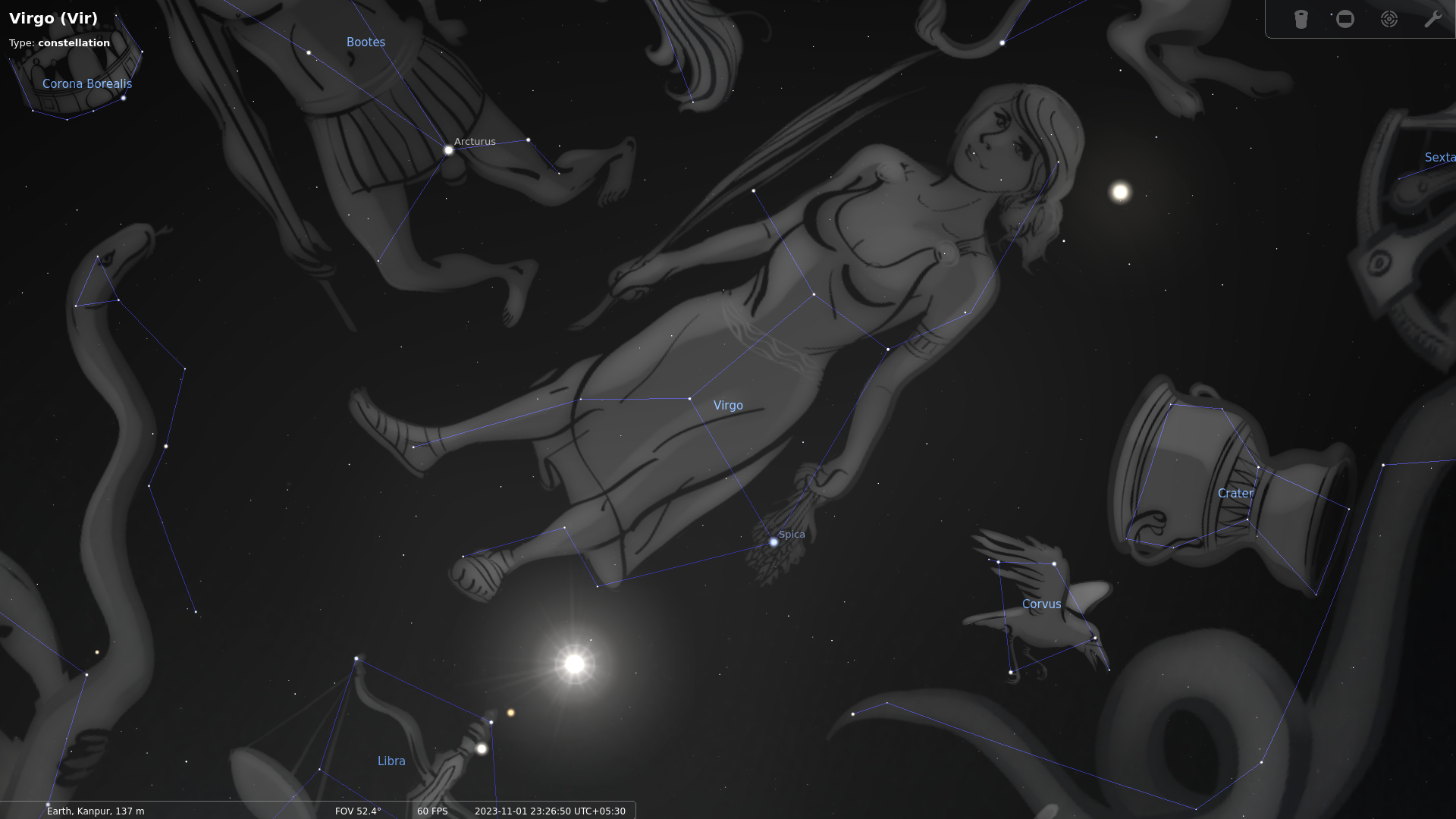Constellations
A constellation is a pattern of stars in the night sky. The word is derived from the Latin word “constellacio”, which means “set of stars”. There are 88 official constellations, all with well defined boundaries. The boundaries of the constellations were defined in 1930 by the International Astronomical Union (IAU).
Some examples of constellations are:
- Ursa Major
- Orion
- Crux
- Taurus
Asterisms
Asterisms are relatively new. Many of them are small patterns, often within a constellation, and some are made of bright stars from more than one constellation. There is nothing official about asterisms, and there are no rules about how big or small they should be. They are just patterns that people have noticed in the night sky and are easily recognizable.
Some examples of asterisms are:
- The Big Dipper (part of Ursa Major)
- The Southern Cross (part of Crux)
- The Summer Triangle (made of stars from Cygnus - Deneb, Lyra - Vega, and Aquila - Altair)
- Pleiades (part of Taurus)
Stars
The 88 constellations are all given three-letter abbreviations that help identify them. Stars that lie within a constellation boundary are referred to with these three-letter codes. In addition, stargazers often use what’s called the genitive form of the constellation name. For example, the genetive form of Orion is Orionis. So, if you are referring to a star in Orion, you would call it “something Orionis”.
The brightest stars in any constellation are usually the ones that are used to make up the pattern, and many of the bright stars stand out so much that they’ve been given proper names. Regardless of whether a star has a proper name or not, though, the bright ones all have Greek letters associated with them.
Bayer letters
The brightest star in any constellation is usually given the designation alpha, represented by the Greek letter \(\alpha\), while the second brightest is beta, \(\beta\) and so on. There Greek letters are known as Bayer letters.
When a star is bright enough to be given its own Bayer letter, that Greek letter is added as a prefix to the three-letter constellation abbreviations. So, if you see a star named as α, many times, it’s the brightest one in that constellation.
Proper names
Some of the brightest stars have a proper name, which you can use interchangeably with the star’s Bayer designation. For example, the brightest star in the constellation Carina is called Canopus, and it also has the Bayer designation \(\alpha\)-Carinae. Most stars have proper names from Latin, Greek or Arabic.
Commonly known Constellations and Asterisms
The following are some of the commonly known constellations and asterisms visible from the sky of Kanpur (some all year round), with a screenshot of each captured in Stellarium, arranged in alphabetical order (also read about the mythical lores about them):
Now that you’ve scrolled till here, BEWARE!
If you plan on applying to become a secretary, you must be familiar with these. If you plan on applying to become a coordinator of the Astronomy Club of IIT Kanpur, you should know these by heart. If you don’t, Tarish’ll come for your soul.
These might be asked during your secretary / coordinator interview if the night sky permits and the present coordinators see it fit. You can thank us later. Believe us, it’s worth it. If you don’t believe us, ask the present coordinators.
Andromeda
Andromeda is a prominent constellation in the northern sky, named after the princess of Greek mythology. It is best known for the Andromeda Galaxy, also called M31, which is the closest spiral galaxy to the Milky Way and can be seen with the naked eye under dark skies. The constellation is depicted as a chained maiden, often associated with the legend of Perseus and his rescue of Andromeda from a sea monster. While Andromeda itself lacks bright stars, its galaxy is a stunning celestial object and is part of the Local Group, which includes the Milky Way and Triangulum galaxies.
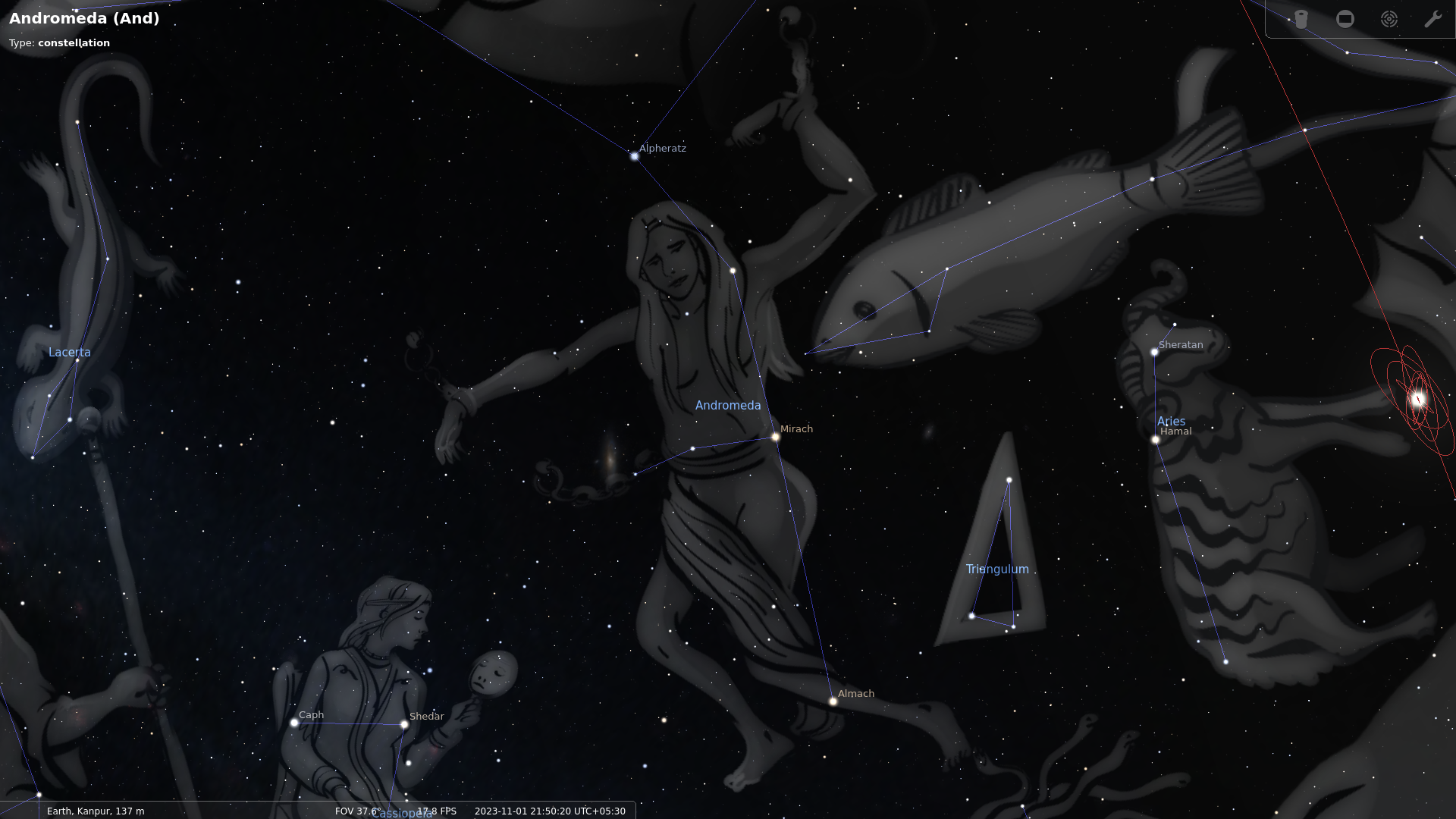
Aquila
Aquila is a constellation in the northern hemisphere, representing an eagle in Greek mythology. It is known for its distinctive “V” shape of stars, which forms the outstretched wings of the eagle. One of the most prominent stars in Aquila is Altair, one of the three stars that make up the Summer Triangle, along with Vega and Deneb. Altair is one of the closest and brightest stars visible from Earth. In ancient mythology, Aquila is often associated with the bird that carried the thunderbolts of Zeus. This constellation holds significance in various cultures and is a prominent feature in the summer night sky.
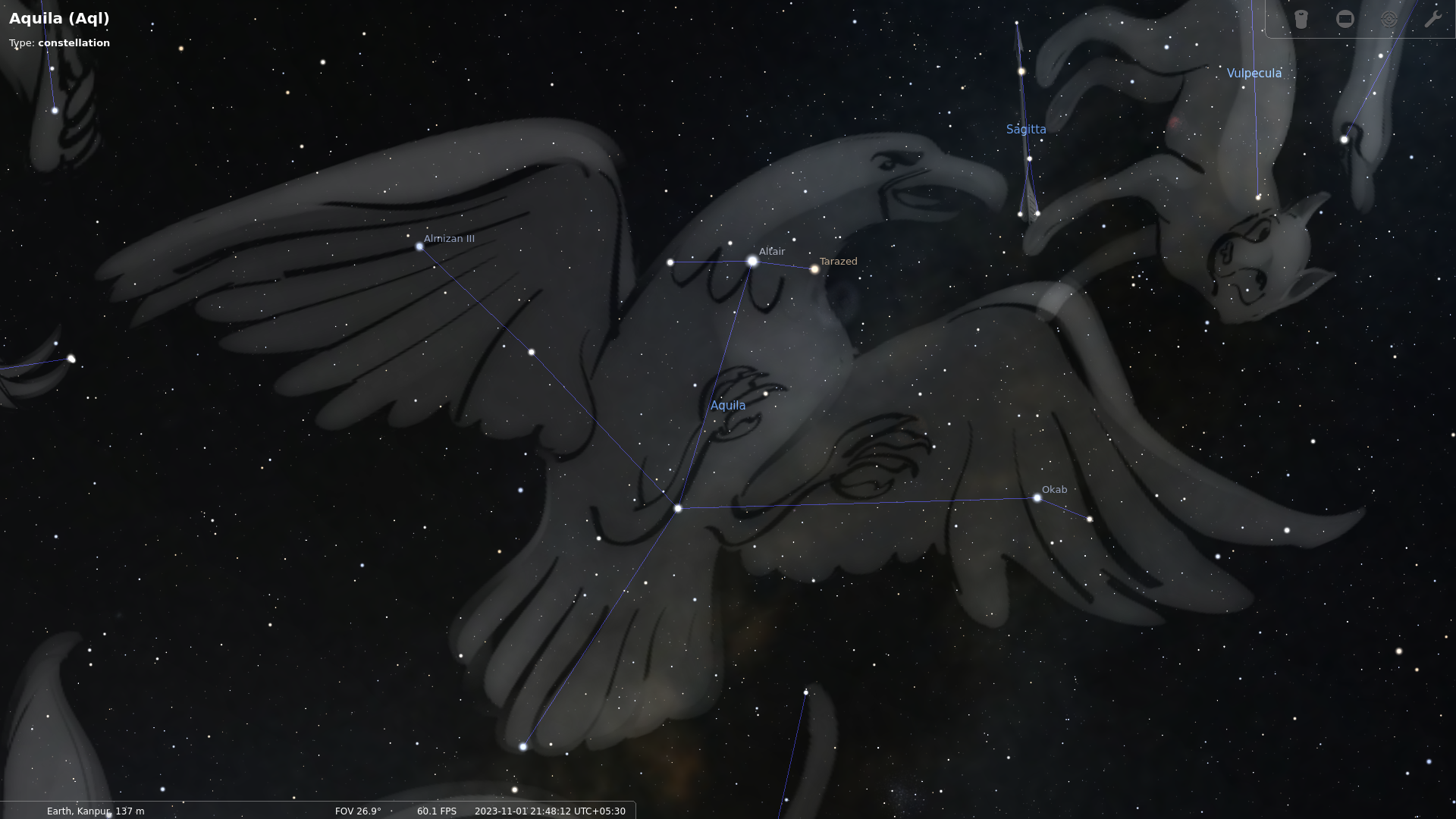
Aries
Aries is a zodiacal constellation located in the northern celestial hemisphere. It is often associated with the ram in Greek mythology and is the first sign of the zodiac. The brightest star in Aries is Hamal, which marks the ram’s head. Aries is known for its relatively dim stars, but it holds cultural and astrological significance. In ancient times, the position of the sun in Aries marked the vernal equinox, signifying the beginning of spring. As a result, Aries has long been associated with themes of new beginnings, energy, and leadership.
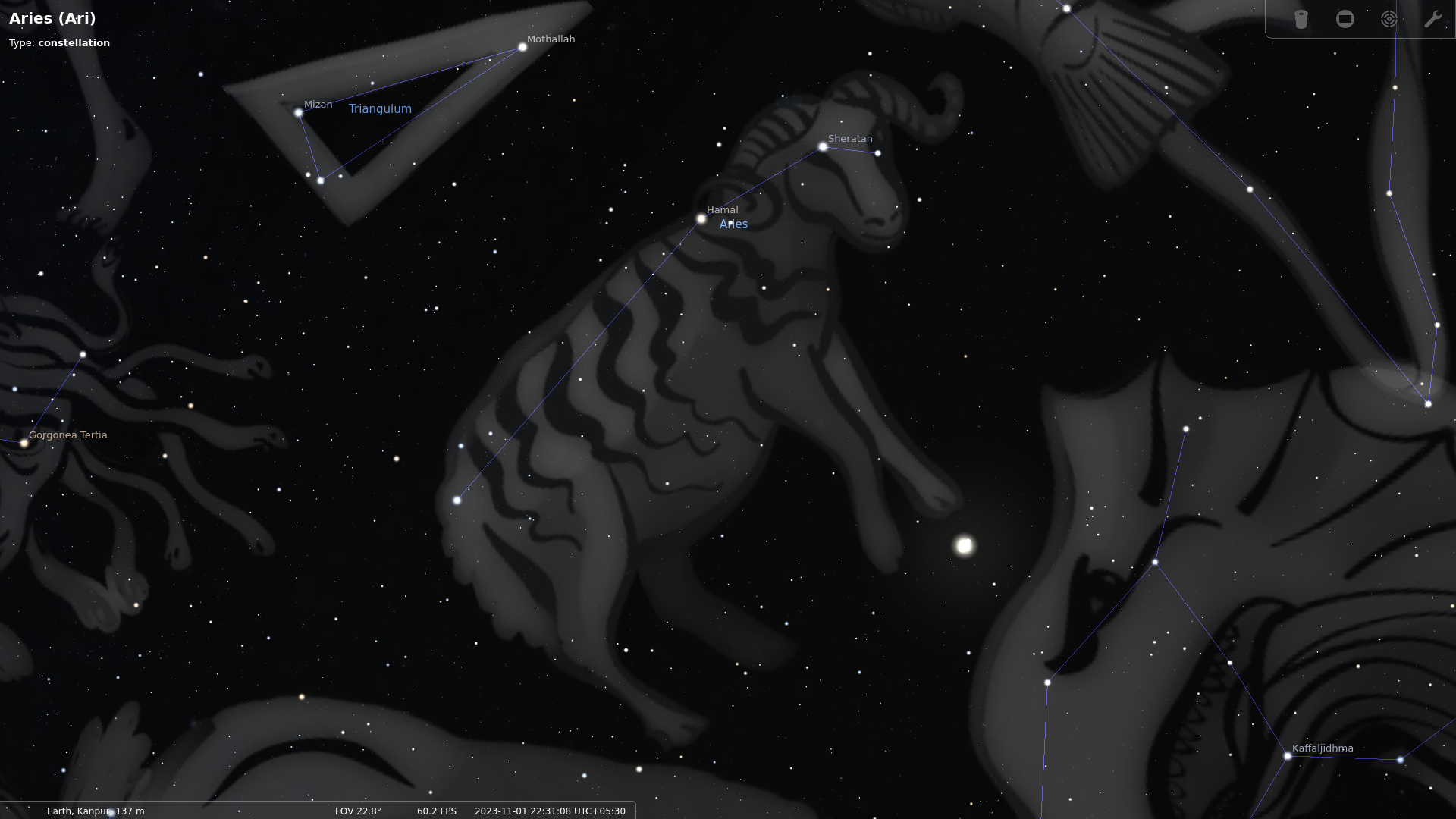
Auriga
Auriga is a constellation located in the northern sky, representing a charioteer in Greek mythology. It is known for its distinctive pentagonal shape formed by bright stars. Capella, one of the brightest stars in the northern hemisphere, serves as the charioteer’s head and is the sixth brightest star in the night sky. Auriga is also home to several star clusters and nebulae, including the star cluster Messier 36. In Greek mythology, Auriga is often associated with Erichthonius, an early inventor of the four-horse chariot. This constellation is a prominent feature in the winter night sky, visible in both the northern and southern hemispheres.
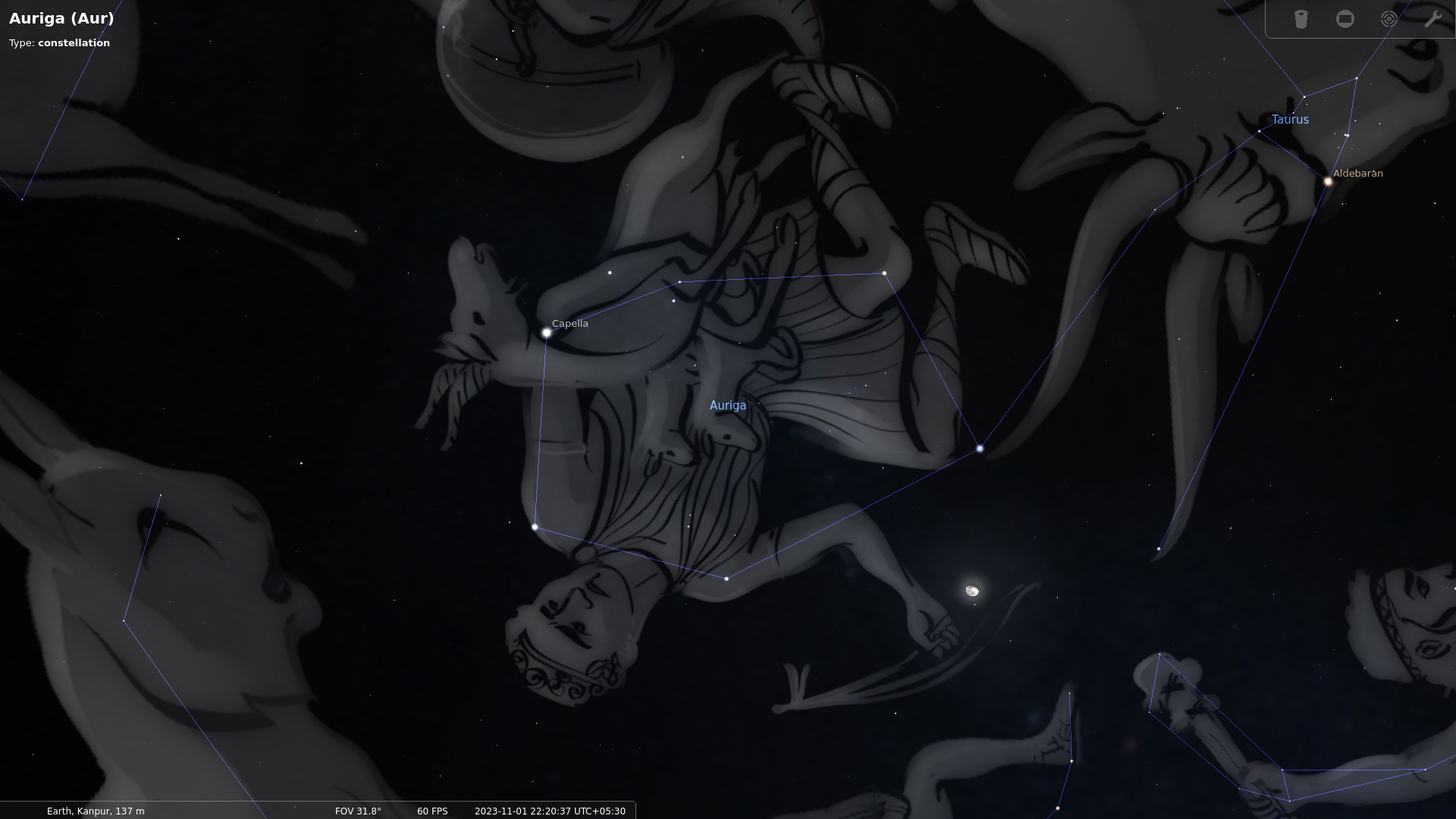
Bootes
Bootes, located in the northern celestial hemisphere, is a constellation prominent in the spring and early summer skies. It represents a herdsman or a plowman in Greek mythology. The brightest star in Bootes is Arcturus, one of the brightest stars in the sky and often described as a golden-hued, red giant. The constellation is recognizable for its kite or ice cream cone shape, with Arcturus marking the herdsman’s left foot. In Greek mythology, Bootes is associated with various figures, including Arcas or Icarius, connected to the legends of bears and winemaking. Bootes is notable for containing galaxies such as the Bootes Void, a region with few galaxies, making it an intriguing area for astronomical study. Visible from both the northern and southern hemispheres, Bootes stands out as a distinctive constellation in the night sky.
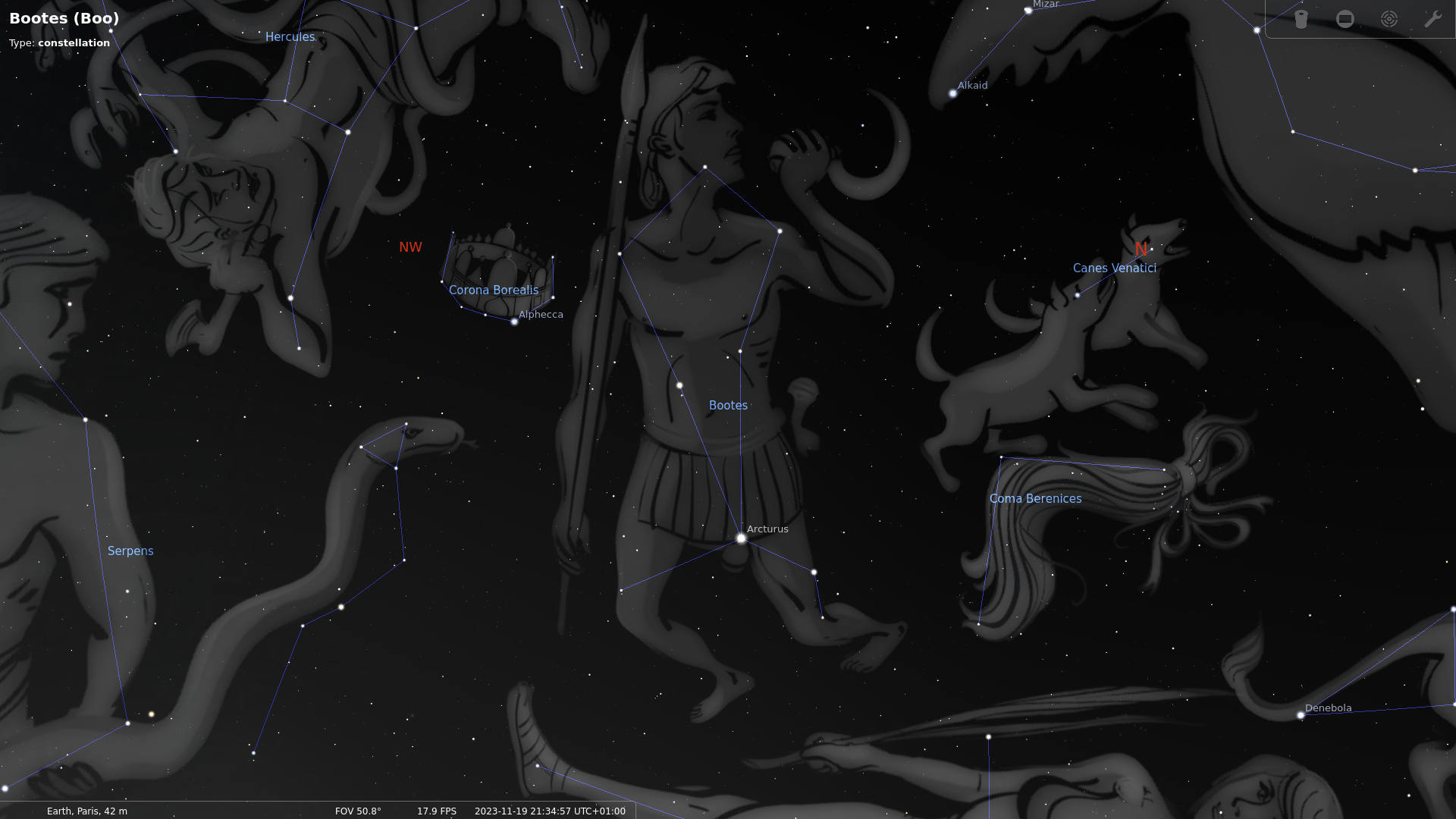
Canis Major
Canis Major is a prominent constellation in the southern celestial hemisphere, representing a large dog in Greek mythology. It is best known for its brightest star, Sirius, which is also the brightest star in the night sky. Often referred to as the “Dog Star,” Sirius is easily visible and dominates the constellation. Canis Major is depicted as a dog following Orion, the hunter, across the night sky. Besides Sirius, there are several other notable stars in this constellation, including Adhara and Wezen. In various cultures, Canis Major has been associated with themes of loyalty, companionship, and vigilance. It is a conspicuous feature in the winter skies of the southern hemisphere and is also visible from most of the northern hemisphere during winter months.
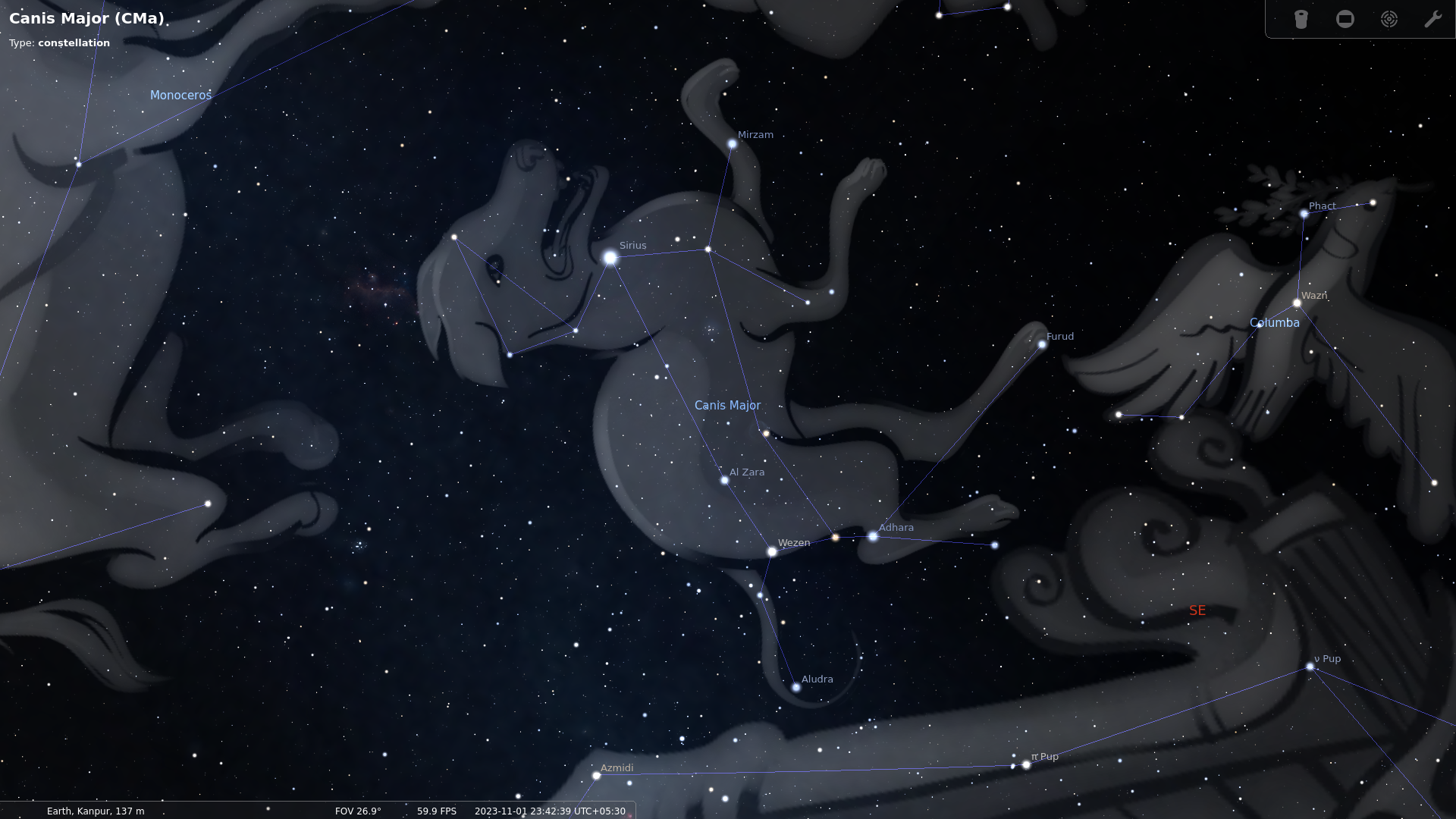
Capricornus
Capricornus, known as Capricorn, is a zodiacal constellation embodying the sea-goat of Greek mythology, a creature that merges elements of a goat and a fish. Positioned in the southern celestial hemisphere, this constellation is modest in its stellar brightness but holds significance as one of the zodiac signs, marking the winter solstice in astrology. Its distinct triangular shape represents a goat’s horn or a fish-tailed creature, with notable features like the globular cluster Messier 30 (M30), a stellar congregation formed billions of years ago.
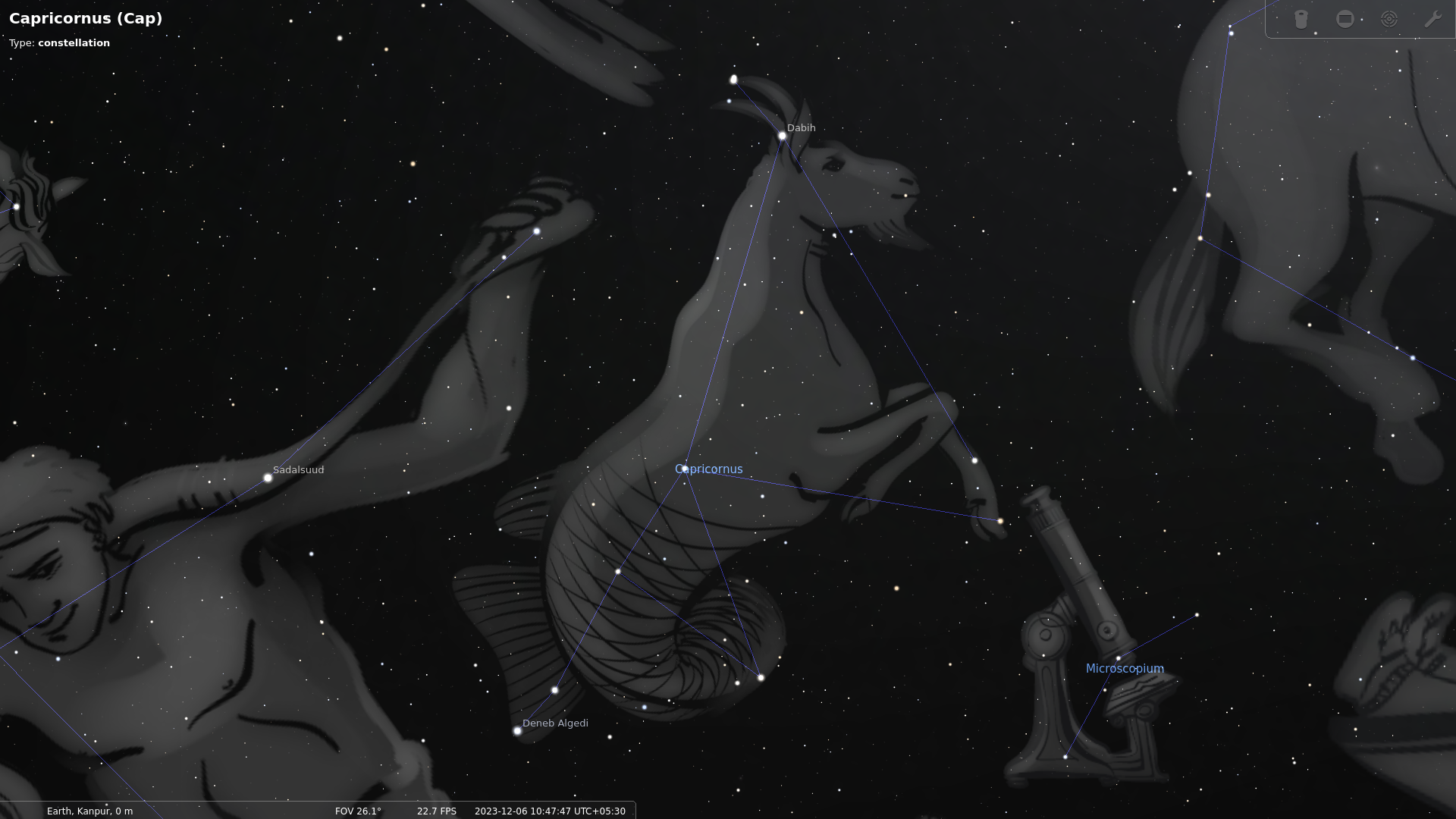
Cassiopeia
Cassiopeia is a distinctive “W” or “M” shaped constellation located in the northern hemisphere. In Greek mythology, it represents Queen Cassiopeia, who boasted about her beauty and incurred the wrath of the sea god Poseidon. The constellation contains several bright stars, with the most prominent being Schedar, Caph, and Ruchbah. Cassiopeia is part of the Perseus constellation family and is known for its rich deep-sky objects, including the open star cluster Messier 52 and the supernova remnant Cassiopeia A. Due to its circumpolar nature, Cassiopeia can be observed year-round in the northern hemisphere, making it a familiar and easily identifiable feature of the night sky.
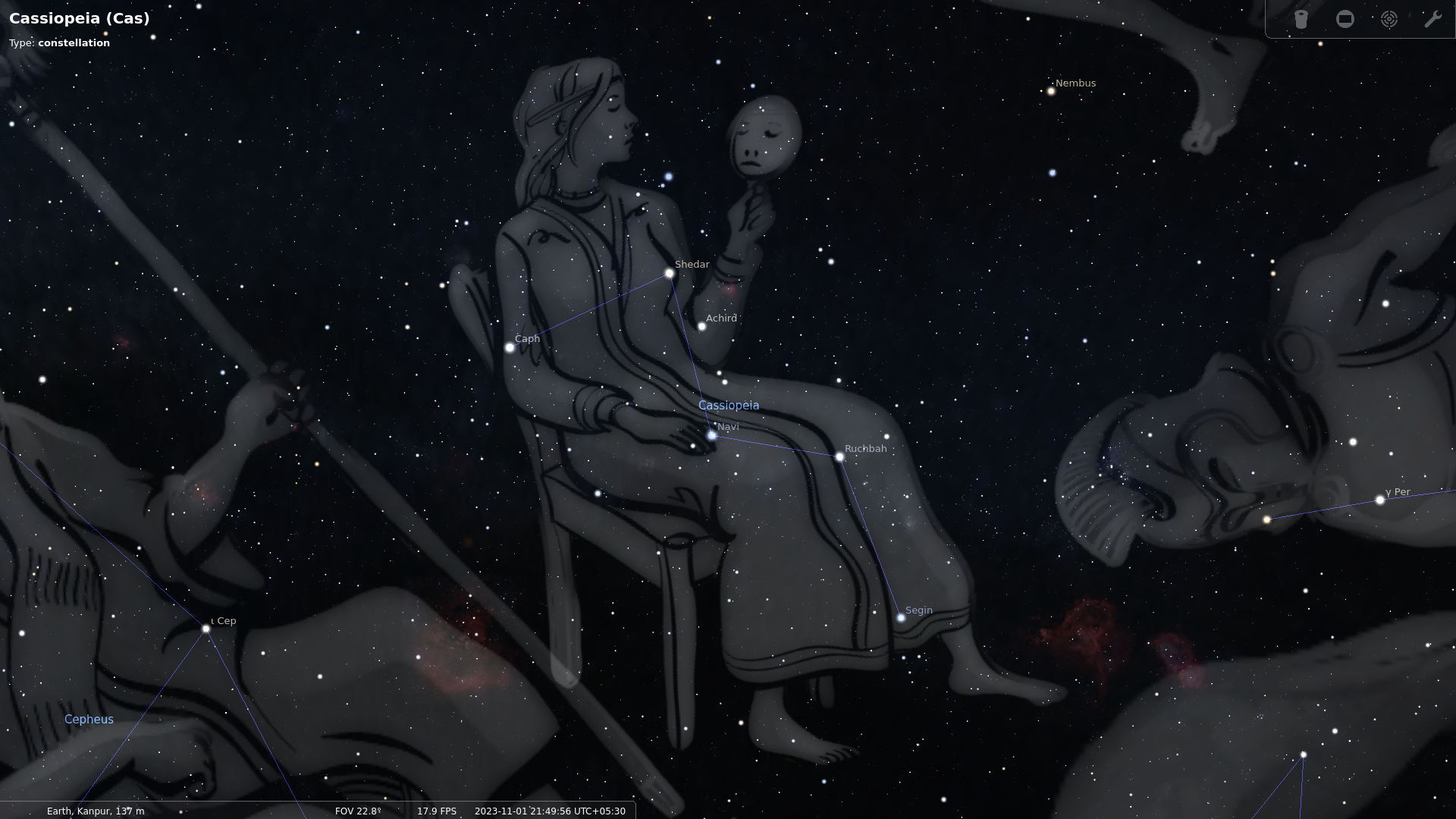
Cepheus
Cepheus is a constellation in the northern celestial hemisphere, named after the King of Aethiopia in Greek mythology. It is often depicted as a monarch holding a scepter and wearing a crown. Notable stars in Cepheus include Alderamin and Errai, which mark the king’s head and heart, respectively. Cepheus is part of a group of constellations known as the Perseus family, which includes Andromeda, Cassiopeia, and Perseus himself. The constellation is rich in deep-sky objects, such as the Garnet Star (Mu Cephei), one of the largest known stars in the Milky Way. Cepheus is visible in the northern hemisphere and is particularly prominent during the autumn months.
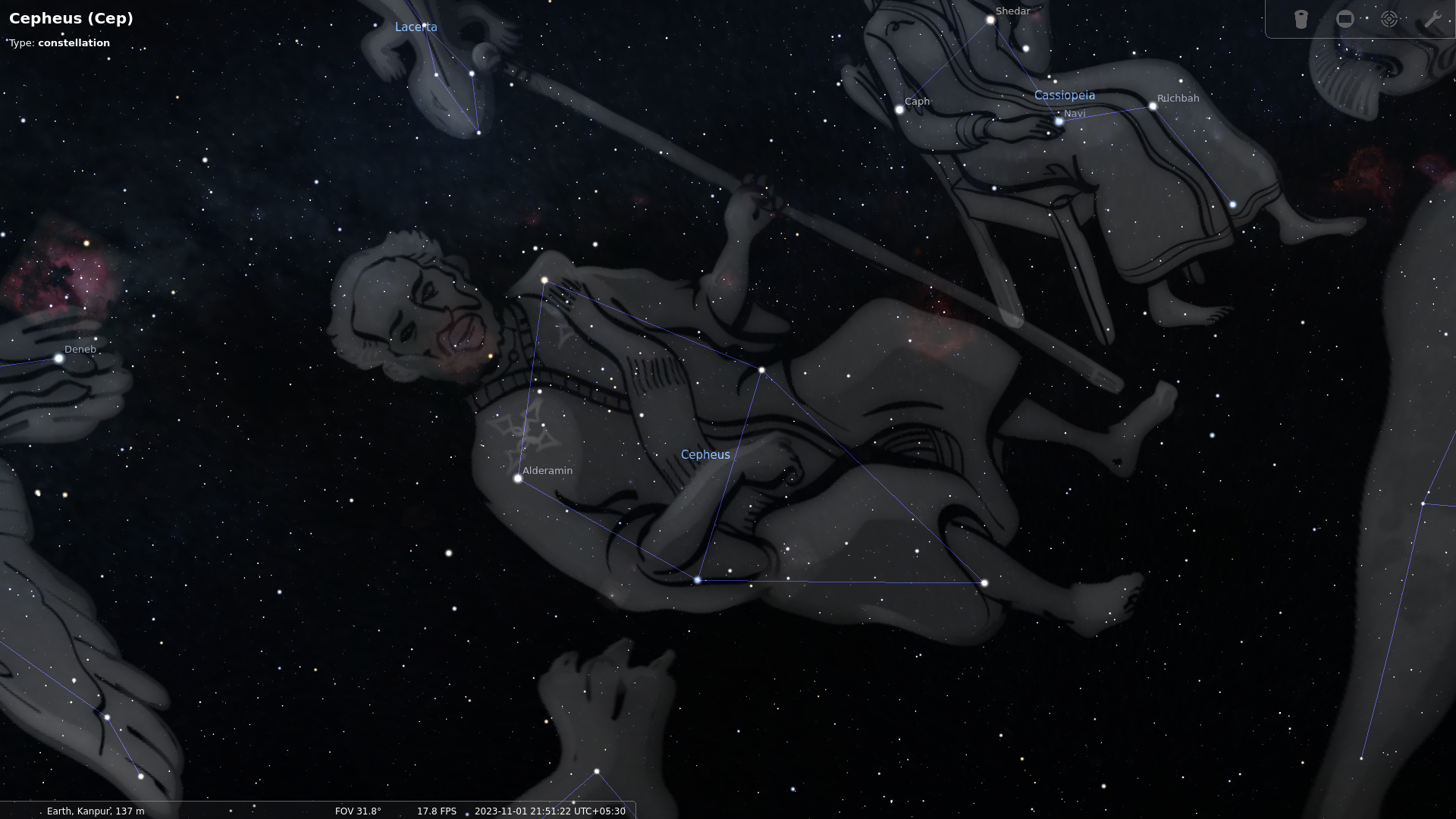
Cygnus
The constellation that shares its name with the club’s annual magazine, Cygnus, often referred to as the Northern Cross, is a prominent constellation in the northern celestial hemisphere. It is named after the Latin word for swan and is associated with various myths across cultures, including the story of Zeus disguised as a swan. The constellation is distinctive for its cross-like shape, formed by the bright stars Deneb, Albireo, Sadr, Gienah, and Delta Cygni. Deneb, marking the tail of the swan, is one of the most luminous stars in the Milky Way. Cygnus is located along the Milky Way, making it rich in deep-sky objects like the North America Nebula and the Veil Nebula. This constellation is visible from both hemispheres and is a prominent feature of the summer night sky in the northern hemisphere.
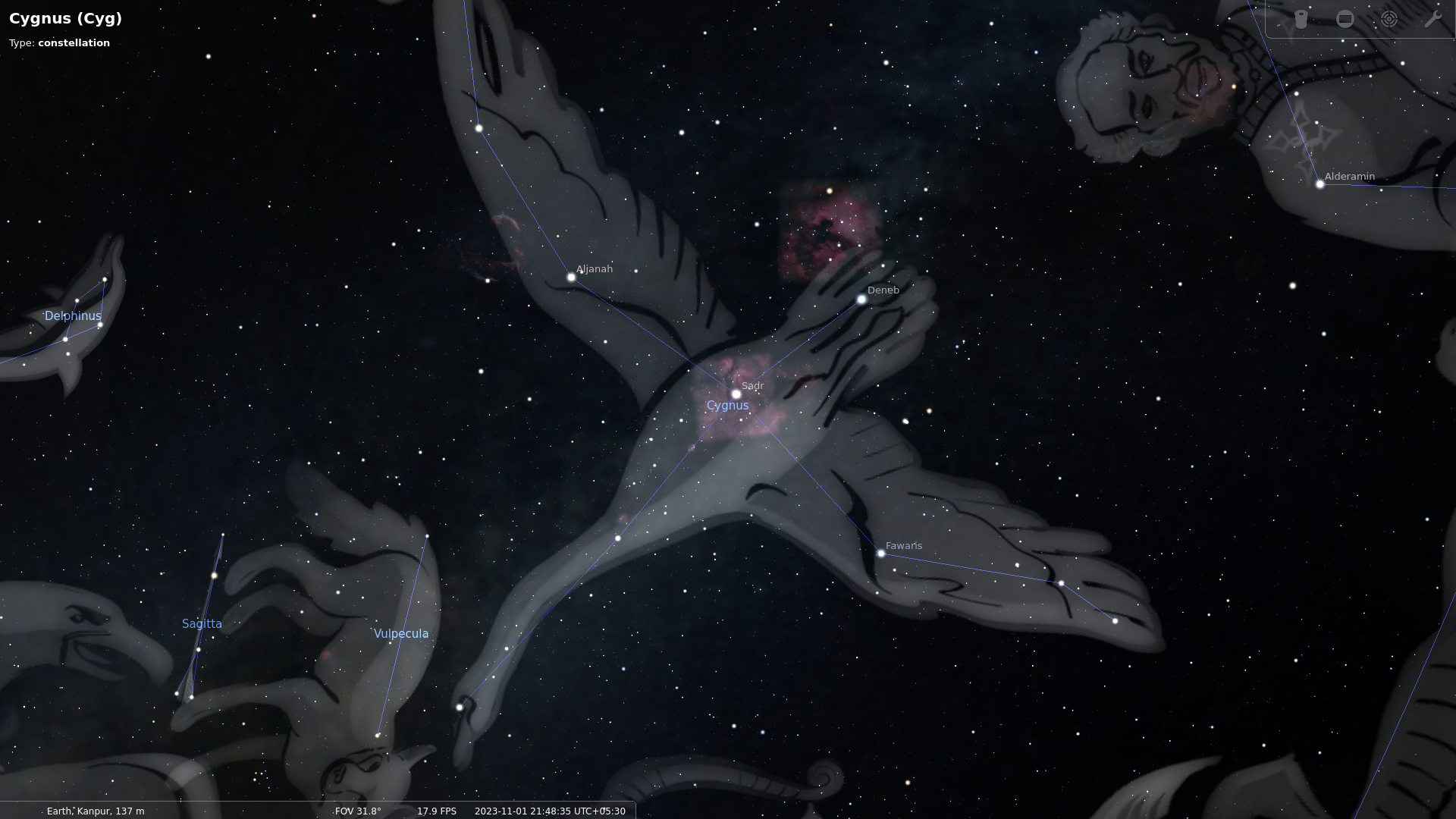
Gemini
Gemini is a zodiacal constellation located in the northern celestial hemisphere. It represents the twins Castor and Pollux from Greek mythology, who were the sons of Zeus. The two brightest stars in Gemini, Castor and Pollux, are among the most well-known in the night sky. Castor is a multiple star system, while Pollux is a giant star with its own planetary system. The constellation is often depicted as two figures standing together, reflecting the close bond between the twins. Gemini is associated with duality and communication due to its twin symbolism. In astrology, it is the third sign of the zodiac, representing curiosity, adaptability, and sociability. Gemini is visible from both hemispheres and can be observed during winter and spring in the northern hemisphere.

Leo
Leo is a zodiacal constellation located in the northern celestial hemisphere. It is one of the most recognizable constellations and represents the lion in Greek mythology. The brightest star in Leo is Regulus, which marks the heart of the lion. Leo is also known for its distinctive pattern of stars that form a backward question mark or sickle shape, representing the lion’s head and mane. In ancient cultures, Leo was often associated with strength, power, and royalty. In astrology, Leo is the fifth sign of the zodiac and is linked with characteristics such as creativity, confidence, and leadership. Leo is visible in both hemispheres and is best observed during the spring and summer months.

Lyra
Lyra, a celestial constellation in the northern sky, holds a rich mythological legacy as the harp of Orpheus from Greek mythology. Its prominent star Vega, one of the brightest in the sky, anchors this constellation. Lyra’s distinctive shape resembles a small parallelogram, with Vega marking its apex, emitting a brilliant bluish-white radiance. Apart from its stellar gem, Lyra boasts the Ring Nebula (M57), a mesmerizing planetary nebula resembling a cosmic smoke ring. As a cultural symbol, Lyra represents the harmony and artistic inspiration associated with music, echoing the myth of Orpheus’s enchanting melodies. This constellation’s presence in the heavens is a reminder of the creative spirit and the profound beauty found in the arts, resonating through the timeless tales and melodies echoing from its mythological origins.

Orion
Orion is one of the most recognizable and prominent constellations in the night sky, named after the mighty hunter from Greek mythology. It is characterized by its distinctive three-star belt, aligned almost perfectly with Earth’s celestial equator. Orion’s prominent stars include Betelgeuse and Rigel, marking his left shoulder and right foot, respectively. The constellation is home to numerous deep-sky objects, such as the Orion Nebula, a stellar nursery located within the “sword” hanging from Orion’s belt. It is visible in both hemispheres and holds cultural significance across various civilizations. Orion is a prominent feature in the winter night sky and is often used as a reference point for stargazing and navigation.
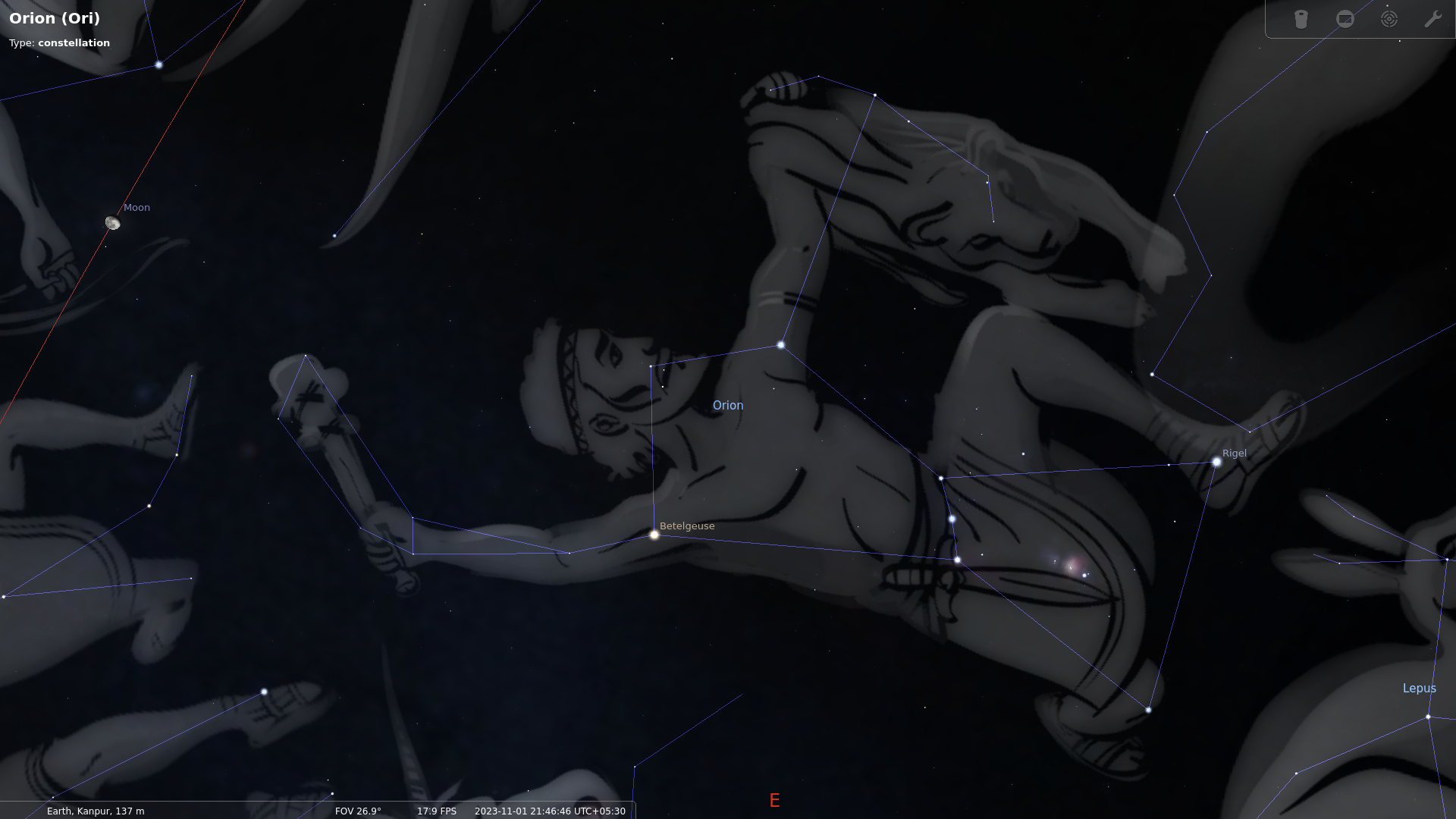
Pegasus
Pegasus is a constellation located in the northern celestial hemisphere, named after the winged horse of Greek mythology. It is known for its distinctive “Great Square of Pegasus,” formed by four bright stars in the constellation. The most notable star in Pegasus is Enif, marking the horse’s muzzle. In Greek mythology, Pegasus was born from the blood of the Gorgon Medusa after she was slain by Perseus. Pegasus is often associated with themes of freedom, flight, and imagination. The constellation is rich in deep-sky objects, including the Andromeda Galaxy (M31), which is the closest spiral galaxy to the Milky Way. Pegasus is visible from both hemispheres, particularly in the autumn and winter months.
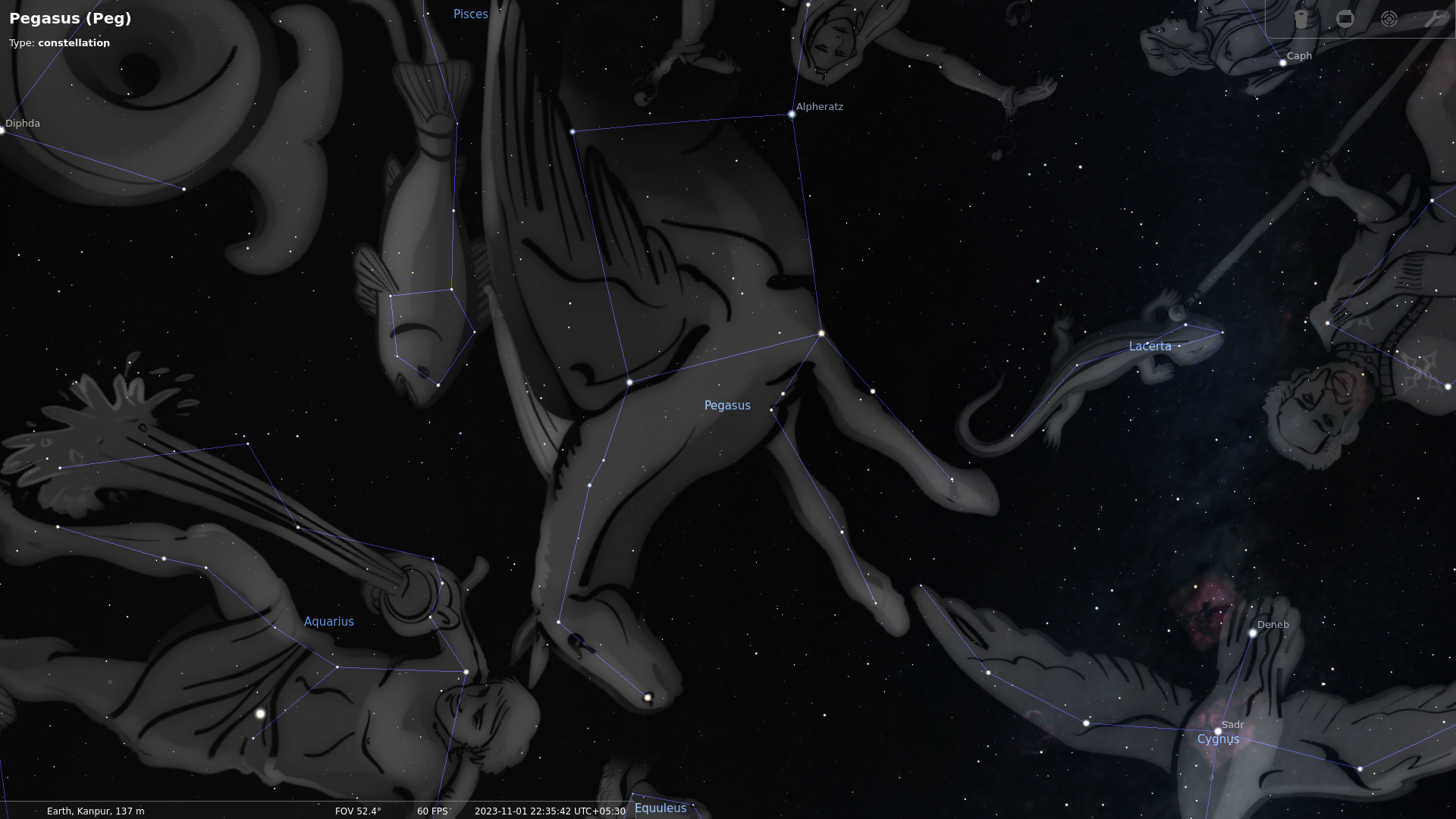
Perseus
Perseus is a prominent constellation in the northern celestial hemisphere, named after the Greek hero who slew the Gorgon Medusa. Notable stars in Perseus include Algol, a variable star often referred to as the “Demon Star” due to its changing brightness, and Mirfak, marking the hero’s shoulder. Perseus is part of the Perseus family of constellations, which also includes Andromeda, Cassiopeia, and Cepheus. The constellation is associated with various myths, including the rescue of Andromeda from a sea monster. Perseus holds cultural significance as a symbol of heroism and valor. It is rich in deep-sky objects, including the Double Cluster (NGC 869 and NGC 884) and the California Nebula (NGC 1499). Perseus is visible from the northern hemisphere and is best observed during the autumn and winter months.
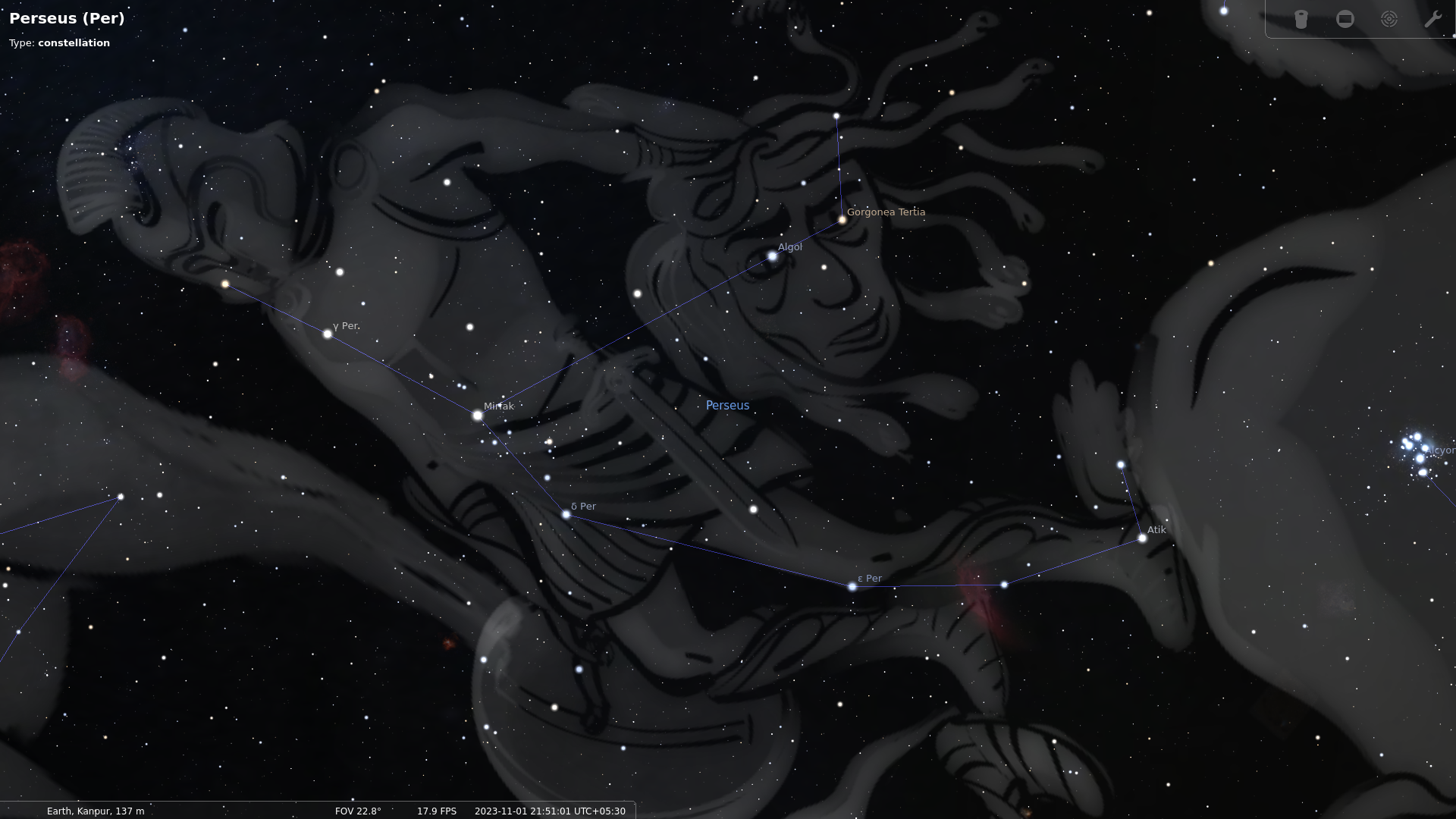
Sagittarius
Sagittarius is a striking constellation visible in the southern hemisphere, named after the centaur of Greek mythology, often depicted as a half-human, half-horse archer. Known for its teapot-shaped asterism, Sagittarius resides in the heart of the Milky Way, boasting a wealth of celestial wonders. Among its treasures is the center of our galaxy, the Milky Way’s bulge, and a plethora of star clusters, nebulae, and cosmic phenomena. The constellation is home to the impressive Lagoon Nebula (M8) and the colorful Trifid Nebula (M20), captivating celestial clouds of gas and dust that birth new stars. Sagittarius’ brightest star, Epsilon Sagittarii (Kaus Australis), marks the “lid” of the teapot, guiding stargazers toward its celestial marvels. In astrology, Sagittarius represents traits of adventure, exploration, and philosophical pursuits, echoing the mythical archer’s quest for knowledge and discovery in the vastness of the cosmos.
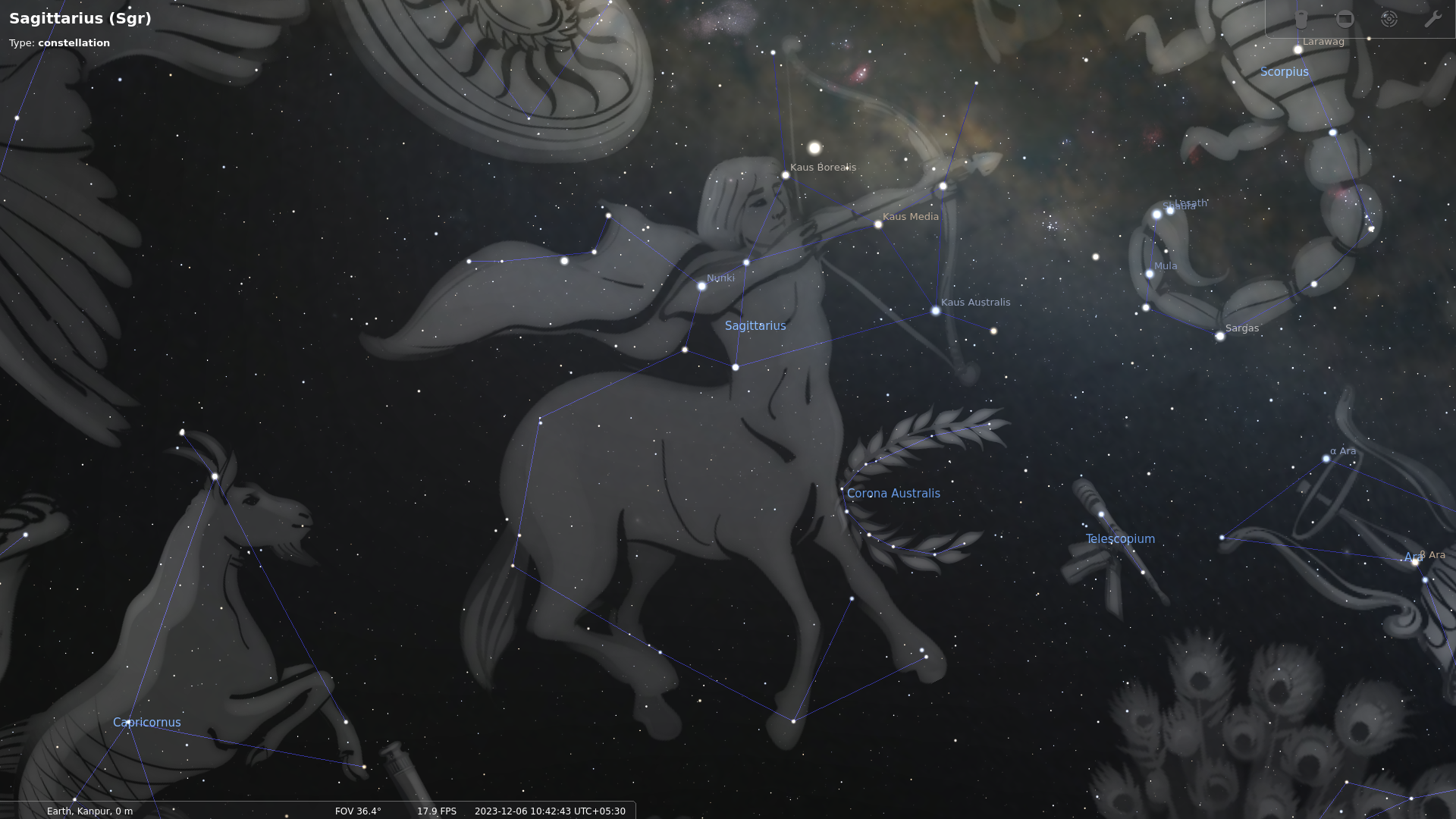
Scorpius
Scorpius is a prominent zodiacal constellation located in the southern celestial hemisphere. It is named after the scorpion from Greek mythology, sent by the goddess Artemis to sting the hunter Orion. The brightest star in Scorpius is Antares, often referred to as the “Heart of the Scorpion” due to its reddish hue. Scorpius is easily recognizable for its distinctive “J” or fishhook shape, which represents the scorpion’s body and tail. This constellation is home to several interesting deep-sky objects, including the open cluster Messier 7 and the globular cluster Messier 4. Scorpius is a prominent feature in the southern night sky during the summer months and can be seen from southern latitudes.
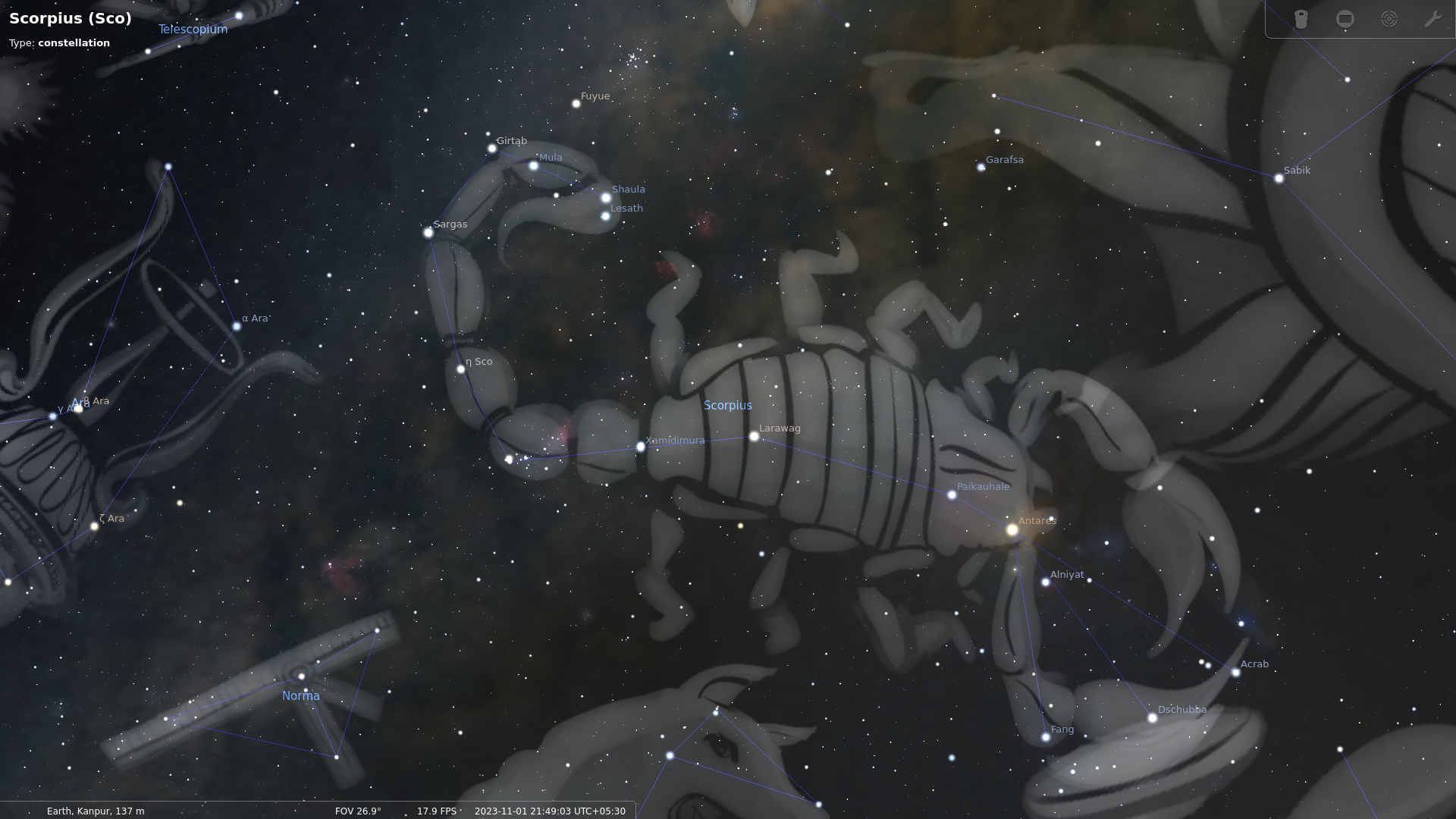
Taurus
Taurus is a zodiacal constellation located in the northern celestial hemisphere. It represents the bull in Greek mythology and is associated with the story of Zeus transforming into a bull to carry Europa across the sea. The most prominent star in Taurus is Aldebaran, which marks the fiery eye of the bull. Another notable feature is the Pleiades star cluster, also known as the Seven Sisters. Taurus is easily identifiable by the V-shaped cluster of stars that form the bull’s face and horns. In astrology, Taurus is the second sign of the zodiac, associated with traits such as determination, stability, and sensuality. Taurus is visible from both hemispheres and is best observed during the winter and spring months in the northern hemisphere.
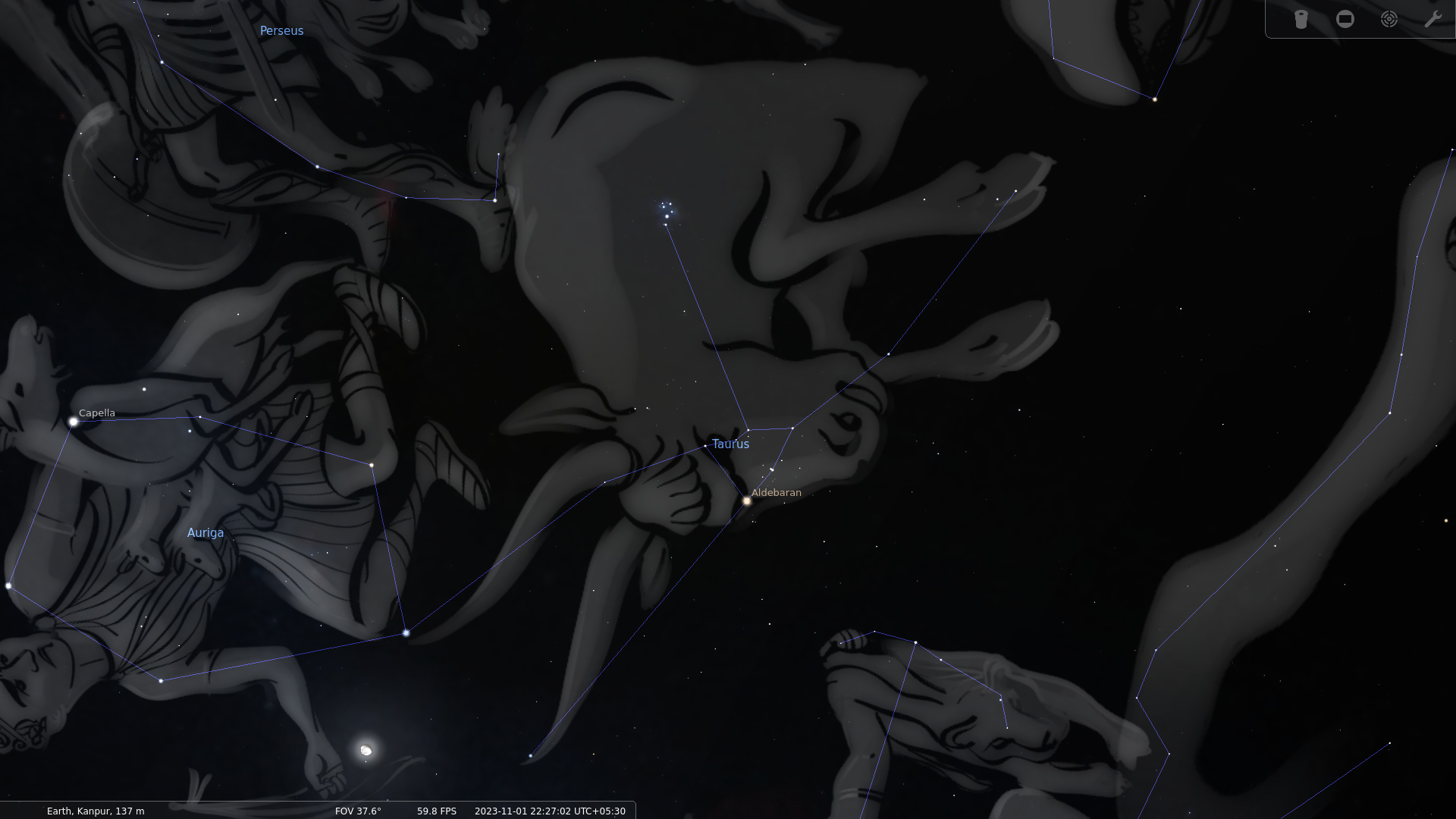
Ursa Major
Ursa Major, also known as the Great Bear, is a large and easily recognizable constellation in the northern hemisphere. It is anchored by seven bright stars forming the “Big Dipper,” which serves as a popular navigational tool. One of the most famous stars in Ursa Major is Dubhe, marking the upper edge of the Dipper. Ursa Major is a circumpolar constellation, meaning it is visible year-round in the northern hemisphere. In various cultures, it has been associated with different myths and legends, often involving a bear. Ursa Major is also known for being home to Messier 81 and Messier 82, two spiral galaxies located in close proximity to each other.
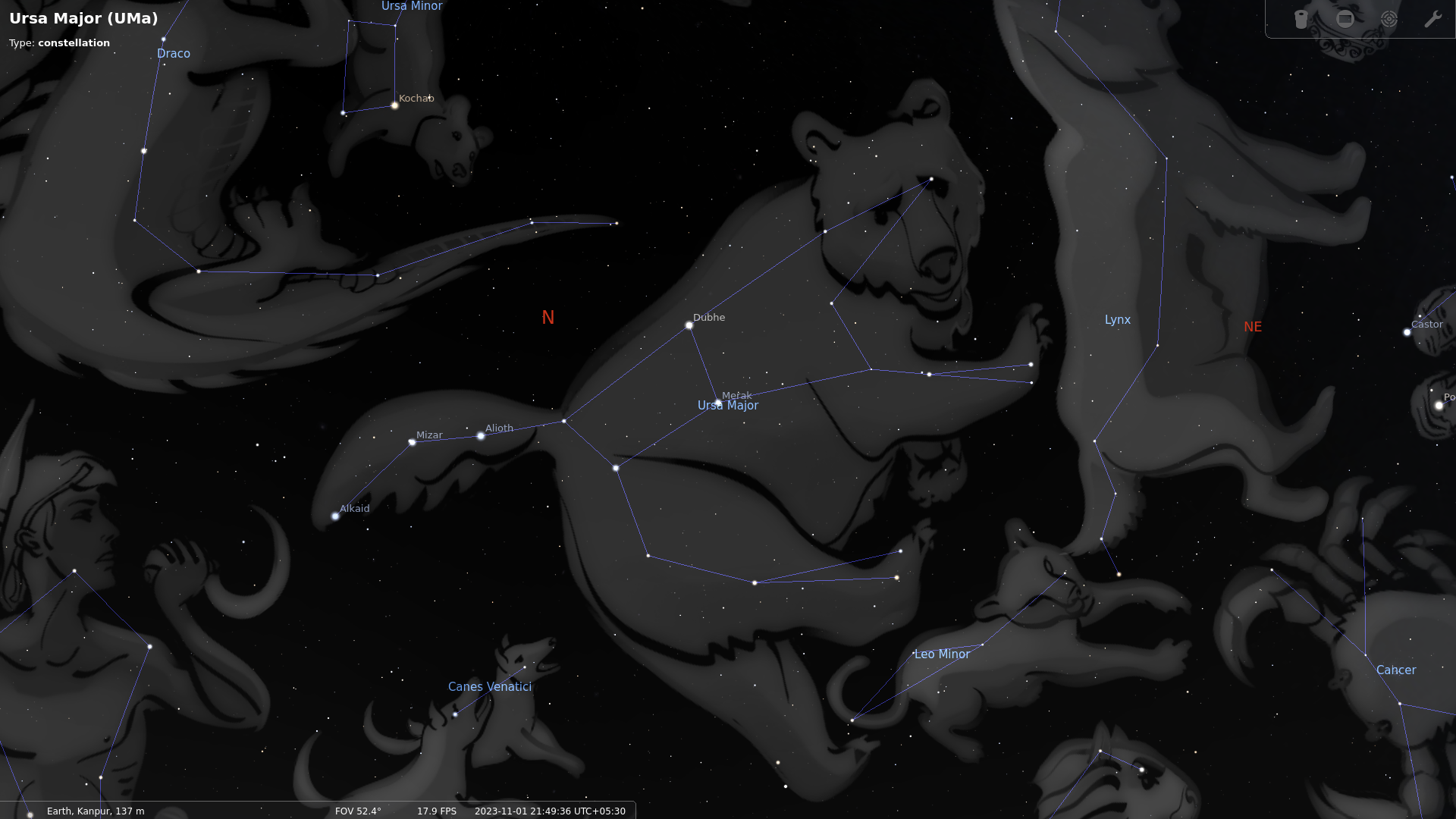
Ursa Minor
Ursa Minor, also known as the Little Bear, is a constellation in the northern celestial hemisphere. It is anchored by the North Star, Polaris, which is located very close to the north celestial pole. Due to its proximity to the pole, Polaris appears almost stationary in the night sky while other stars appear to revolve around it. This makes Polaris a crucial navigational aid. Ursa Minor is often depicted as a smaller, less prominent version of Ursa Major, with Polaris marking the tip of the Little Bear’s tail. In Greek mythology, Ursa Minor is associated with the nymph Callisto, who was transformed into a bear by Zeus. The constellation is visible year-round in the northern hemisphere and serves as a reliable reference for determining cardinal directions.
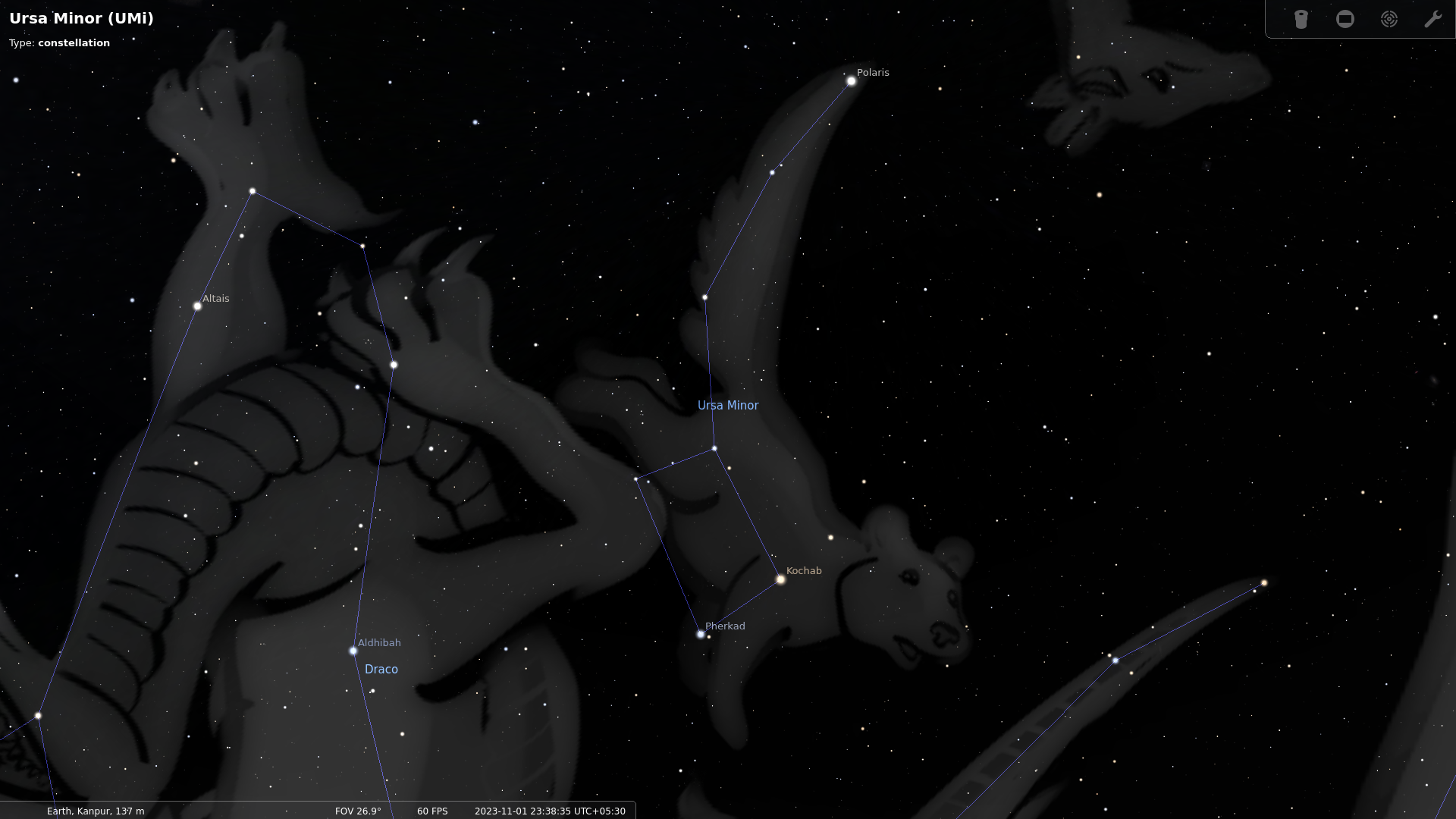
Virgo
Virgo is a zodiacal constellation located in the northern celestial hemisphere. It represents the maiden in Greek mythology and is associated with various myths, including the story of Demeter and her daughter Persephone. The brightest star in Virgo is Spica, which marks the wheat sheaf held by the maiden. Virgo is often depicted with a sheaf of wheat or a bundle of harvested crops. In astrology, Virgo is the sixth sign of the zodiac, associated with traits such as practicality, attention to detail, and a desire for order. Virgo is visible from both hemispheres and is best observed during the spring and summer months in the northern hemisphere. It is also notable for being home to the Virgo Cluster, a rich collection of galaxies located within the constellation.
